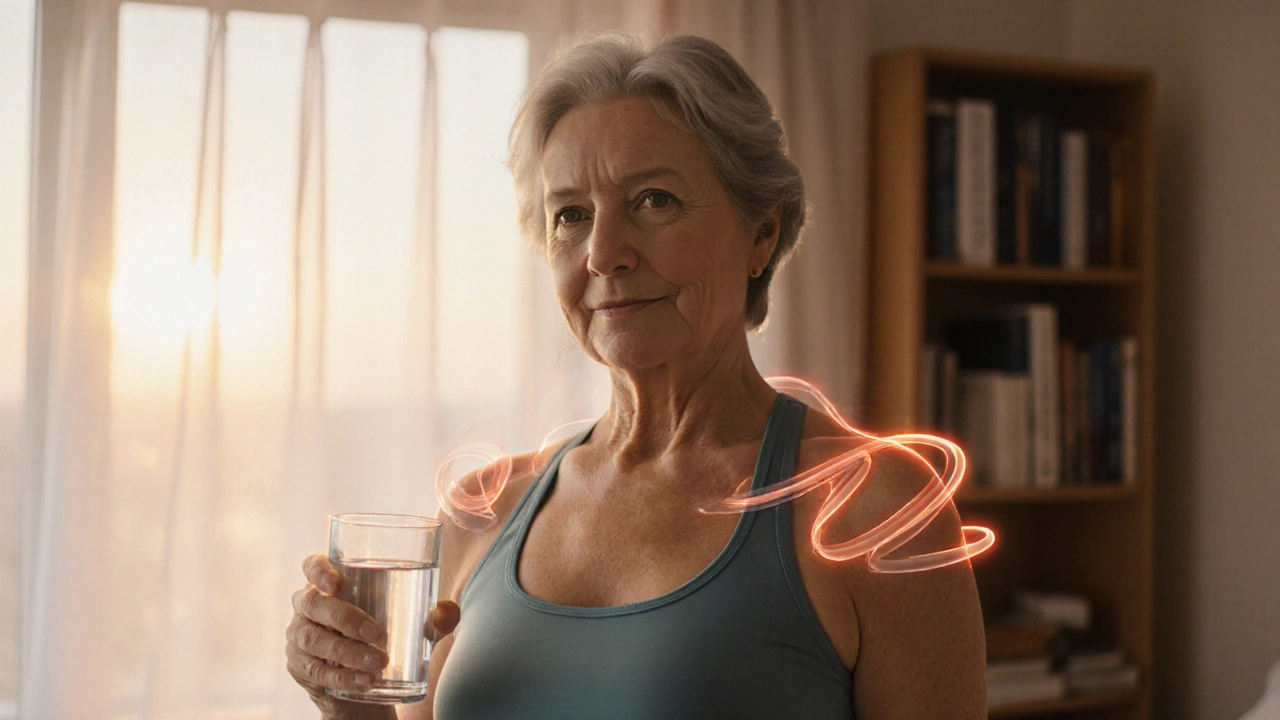Menopause Exercise Checker
Personalized Exercise Plan
Select the menopause symptoms you're experiencing to get customized exercise recommendations based on clinical guidance.
Your Recommended Exercise Plan
Based on your selected symptoms, we recommend this balanced exercise approach to help manage your menopause symptoms.
Cardiovascular
3-5 days/week, 30-45 minutes
Brisk walking, cycling, or swimming
Strength Training
2-3 days/week, 20-30 minutes
Dumbbell squats, resistance band rows
Mind-Body
2-4 days/week, 20-30 minutes
Hatha yoga, guided meditation
When Menopause is the natural decline in ovarian hormone production that marks the end of a woman's reproductive years, usually occurring between ages 45 and 55, many women notice changes in energy, mood, and body composition. One of the most effective ways to smooth that transition is menopause exercise. Regular physical activity not only tackles hot flashes and sleep issues but also protects bone health and keeps the heart ticking.
Quick Takeaways
- Aim for at least 150 minutes of moderate cardio each week.
- Include strength training twice weekly to preserve muscle and bone.
- Flexibility and mind‑body workouts help manage stress and hot flashes.
- Start slow, listen to your body, and adjust intensity as symptoms shift.
- Use the checklist at the end to build a personalized routine.
Why Exercise Matters During Menopause
Research from the British Menopause Society shows that women who engage in regular Exercise experience 30% fewer severe hot flashes and a 20% lower risk of osteoporosis. The hormone drop lowers estrogen, which normally helps keep bones dense and metabolism steady. Without intervention, bone density can shrink by up to 1% per year, and weight gain often piles on around the abdomen.
Cardiovascular workouts boost heart health, helping control blood pressure that tends to rise after menopause. Strength training stimulates muscle protein synthesis, counteracting the natural loss of lean mass. Meanwhile, mind‑body practices like yoga release cortisol, reducing mood swings and improving sleep quality.
Exercise Types and Their Menopause Benefits
Not every workout feels the same, and each has a unique role in easing menopausal changes.
| Type | Key Benefits | Suggested Frequency | Sample Activity |
|---|---|---|---|
| Cardiovascular | Improves heart health, burns calories, reduces hot flashes | 3‑5 days/week, 30‑45 min | Brisk walking, cycling, swimming |
| Strength Training | Maintains muscle mass, boosts bone density, stabilizes blood sugar | 2‑3 days/week, 20‑30 min | Dumbbell squats, resistance‑band rows |
| Flexibility | Increases joint range, alleviates stiffness, aids posture | Daily, 5‑10 min | Static stretching, Pilates |
| Mind‑Body (Yoga/ Tai Chi) | Reduces stress, balances hormones, improves sleep | 2‑4 days/week, 20‑30 min | Hatha yoga, guided meditation |
Each category works together. For example, a 45‑minute walk (cardio) paired with a 15‑minute resistance‑band circuit (strength) followed by 10 minutes of gentle yoga (mind‑body) covers all bases.

Building a Menopause‑Friendly Workout Plan
- Assess your current level. Use the “talk test” - you should be able to converse while exercising. If you’re new, start with 10‑minute walks.
- Set realistic goals. Aim for a mix: 150 min moderate cardio, two strength sessions, and flexibility work.
- Choose low‑impact cardio. Joint‑friendly options (elliptical, water aerobics) reduce injury risk while still raising heart rate.
- Prioritize strength on non‑consecutive days. Muscles need recovery; alternate upper‑body and lower‑body workouts.
- Incorporate balance drills. Single‑leg stands or tai chi moves counteract the postural changes that can accompany bone loss.
- Listen to hot‑flash cues. If you feel a wave coming, pause, hydrate, and shift to a cooler environment - a gentle stretch can tide you over.
- Track progress. A simple log noting minutes, perceived effort, and symptom rating helps you spot patterns.
Managing Specific Menopause Symptoms with Exercise
Hot flashes: Moderate aerobic activity improves blood circulation, which can regulate temperature spikes. Cool‑down periods and breathable clothing are essential.
Sleep disturbances: Evening yoga or a short stretch routine lowers cortisol, preparing the body for rest. Avoid high‑intensity cardio within two hours of bedtime.
Mood swings: Endorphin release from any activity lifts mood. Group classes add social support, further stabilizing emotions.
Weight gain: Strength training increases resting metabolic rate, meaning you burn more calories even at rest. Pair with balanced nutrition for best results.

Common Pitfalls and How to Avoid Them
Many women stop too quickly when symptoms flare, fearing exercise will worsen them. In reality, consistent, moderate activity usually lessens severity. If you feel overly fatigued, cut intensity, not duration, and focus on movement like walking or gentle stretching.
Another trap is ignoring recovery. Hormonal shifts can affect joint lubrication, so incorporate at least one rest day and use foam rolling or massage to keep tissues supple.
Finally, avoid the “one‑size‑fits‑all” mindset. Personal preferences, medical history, and current fitness level dictate the optimal mix of workouts. Consulting a physiotherapist familiar with menopause can fine‑tune your plan.
Quick Checklist for an Active Menopause
- ✅ 150 min moderate cardio per week (e.g., brisk walking, swimming)
- ✅ Two strength sessions targeting all major muscle groups
- ✅ Daily flexibility work - 5‑10 min stretching or Pilates
- ✅ Two mind‑body sessions for stress relief
- ✅ Hydrate before, during, and after workouts
- ✅ Wear breathable, moisture‑wicking fabrics
- ✅ Schedule workouts at a time when symptoms are mild
- ✅ Keep a symptom‑exercise journal
How often should I exercise during menopause?
Aim for at least 150 minutes of moderate‑intensity cardio each week, plus two strength‑training sessions and daily flexibility or mind‑body work. Adjust based on how you feel, but consistency matters more than intensity.
Can exercise actually reduce hot flashes?
Yes. Studies show that women who engage in regular aerobic activity report up to 30 % fewer severe hot flashes. The key is moderate intensity and staying cool during workouts.
What type of strength training is safest?
Start with body‑weight moves (squats, lunges, push‑ups) or resistance bands. Progress to light free weights as confidence grows. Focus on controlled tempo and proper form to protect joints.
Should I exercise on days when I have severe symptoms?
Listen to your body. Light activity like walking or gentle stretching is usually fine and can even relieve symptoms. Skip high‑intensity sessions until you feel better.
Do I need special equipment?
No. Most benefits come from simple tools: a pair of dumbbells, resistance bands, a sturdy chair for balance, and comfortable shoes. If you prefer classes, a yoga mat and supportive footwear are enough.


I am a pharmaceutical expert with over 20 years of experience in the industry. I am passionate about bringing awareness and education on the importance of medications and supplements in managing diseases. In my spare time, I love to write and share insights about the latest advancements and trends in pharmaceuticals. My goal is to make complex medical information accessible to everyone.